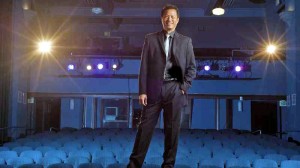East West Players toast artistic director
LOS ANGELES—For Tim Dang, meeting Lea Salonga for the first time is one of the highlights in his 20-year tenure as the producing artistic director of East West Players (EWP), the United States’ largest producing organization of Asian-American artistic work, and the longest-running professional theater of color. Many Filipino-American actors and stage talents, including respected director Jon Lawrence Rivera, have been tapped by EWP in its productions for the past 48 years.
The last 20 of those 40-plus years have been under Tim’s successful term, so EWP is celebrating this milestone with a one-night-only benefit dinner and show on Aug. 17. A key achievement in Tim’s leadership is EWP’s move from a small theater to a state-of-the-art mid-size home, the David Henry Hwang Theater, in LA’s Little Tokyo.
Fil-Am actor Reggie Lee will host “One Night Only: Tim’s 20th,” which includes a reception that starts at 6 p.m., followed by an alfresco dinner and a special show featuring some of the outstanding talents who have graced the EWP stage, including Joan Almedilla, Elijah Rock, Lito Villareal, Antoine Diel, Keo Woolford, Jenni Selma, Ethan Le Phong and Orville Mendoza. More details about the event, which benefits EWP’s artistic and educational programs, are available at www.eastwestplayers.org.
Excerpts of our e-mail interview with Tim:
Tim, congratulations! What are the 20 things that come to mind as you celebrate this milestone?
Article continues after this advertisement1. Our 1994 production of “Sweeney Todd” in our 99-seat space on Santa Monica blvd. in Silver Lake that won awards and critical praises.
Article continues after this advertisement2. Moving from Silver Lake to a 240-seat state of the art theater in downtown LA’s Little Tokyo.
3. Meeting President Bill Clinton when EWP performed at the LA Democratic Convention.
4. Being recognized by the James Irvine Foundation with the Leadership Award, only the second artist to receive this honor.
5. Our street, Judge John Aiso St., was closed for nine months, following 9/11 as a staging area for the Los Angeles Police Department and thinking how can we do “business as usual” amid its closure.
6. Having Stephen Schwartz, author of “Pippin,” “Wicked” and “The Fantasticks,” come to the opening night of our hip-hop anime version of “Pippin.”
7. When Danny Glover and Nobu McCarthy starred in a sold-out run of “Yohen” in 1999.
8. El Niño delayed the opening of our new theater when nearly 38 inches of rain fell in 1997.
Anniversary
9. When founding artistic director, Mako, was set to make his acting return to EWP for our 40th anniversary, but had to cancel the production two weeks into rehearsal when he was diagnosed with esophageal cancer.
10. EWP hosted the first National Asian-American Theater Conference in 2006.
11. EWP, with TeAda Productions, hosted the Third National Asian American Theater Conference and Festival in 2011.
12. Meeting Lea Salonga for the first time at our 43rd Anniversary Visionary Awards Gala in 2009.
13. Directing George Takei as Dr. Martin Dysart in the Tony Award-winning play, “Equus” (2005).
14. Having Lynn Arthurs as the president/chair of the board of directors for 20 years.
15. When “Pippin” overtook “Pacific Overtures” as the highest-grossing show in EWP’s history.
16. When “Imelda, A New Musical” had the largest one-week gross of ticket sales, nearly $17,000.
17. Meeting composer Stephen Sondheim in a bar one on one after the Ovation awards at the former Shubert Theater in Century City, California.
18. Having the first Visionary Awards gala honoring the founders of EWP in 1996 at the Biltmore Hotel.
19. When copresidents of the board, John Kobara and Wenda Fong, asked me if I would consider being the artistic director of EWP in 1993.
20. Having celebs like the late James Gandolfini, Melissa Manchester, Jet Li and Bette Midler attend a show at EWP.
How have the visibility and influence of Asian Pacific Islanders in the US performing arts changed in the past 20 years?
The rapid growth of the various Asian and Pacific Islander communities in the US have created an abundance of stories—not only immigrant stories, but multigenerational stories to tell on stage, film and TV. The talent has gotten much more experienced, and the opportunities have increased. Actors like Lucy Liu, Daniel Dae Kim and Sandra Oh are now stars.
How has EWP engaged the topic of race relations in its productions over the years?
One critical issue we face as an Asian-American performing arts group is that there is an increasing number of performers of mixed race. By 2030, nearly 50 percent of Americans under the age of 30 will be of mixed race. As performers, how will these mixed-race artists be cast?
The important thing is dialogue—we must continue to talk about it. As long as we talk about it, EWP is respected for bringing up what can sometimes be a challenging subject matter.
What are your hopes and goals for EWP in the next 20 years?
To include more diversity on the EWP stage. To be able to tour its shows across America. To lead the American stage in encouraging more diversity on the American stage.
E-mail [email protected]. Follow him at https://twitter.com/nepalesruben.
